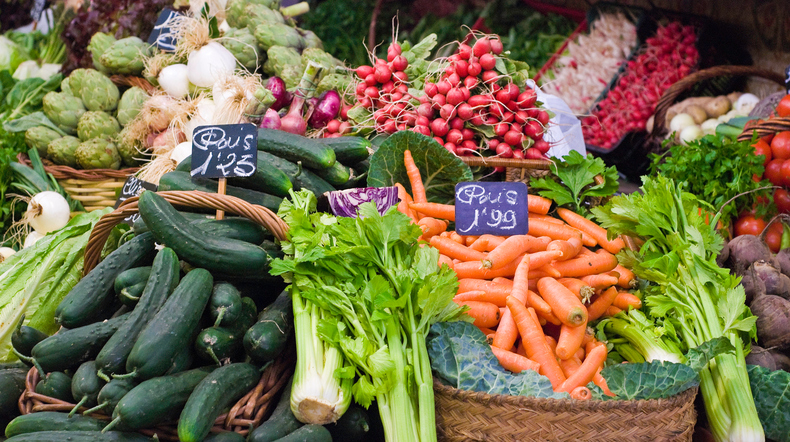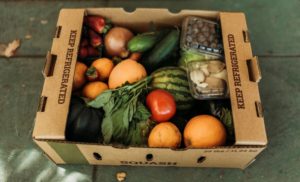
New study suggests that cities can encourage local food production and consumption through smarter regulations.
The local food movement has been booming over the last several years. The number of farmers’ markets across the country has nearly doubled in the last decade, and a recent Pew Research Center poll found that a majority of people in the United States had bought locally grown produce in the previous month. The enormous interest in eating locally has even led to the coinage of a new word: locavore.
Local food production and consumption offer a variety of benefits, which two legal scholars, Patricia Salkin and Amy Lavine, discuss in a recent paper. Because of these purported benefits, Salkin and Lavine argue that local and state governments should follow the example of some of their peers and update their zoning and land use regulations to encourage more local food production.
Salkin and Lavine tout the advantages of “foodsheds”—geographic areas surrounding urban areas that can provide some of the food that city-dwellers consume. For instance, Salkin and Lavine point to potential environmental benefits: Small farms may use fewer chemicals and produce less waste than large industrial farms. And it requires much less fuel to transport produce to a nearby city than it does to transport produce across the country.
Lowering fuel usage in the food industry is no small consideration: According to the National Resources Defense Council, one year of the “fruits, nuts, and vegetables” flown into California alone accounted for more carbon dioxide production than that which is consumed by 12,000 cars.
Foodsheds also offer health benefits, according to Salkin and Lavine. They note that researchers have “advocated a regional foodshed model as one of the most promising strategies for curbing childhood obesity” because of foodsheds’ potential to provide more healthful foods in underserved communities at more affordable prices.
More accessible local fruits and vegetables could help adults better meet their nutritional needs as well. The Centers for Disease Control and Prevention reported in 2015 that only around 10 percent of American adults eat the recommended daily amount of fruits and vegetables. Although one reason for this deficiency may be that people make poor health choices, many Americans also lack an accessible supply of fruits and vegetables. The United States Department of Agriculture (USDA) recommends that adults eat “2.5 to 3 cups of vegetables a day,” but researchers found that “only 1.7 cups per person are available.”
The environmental and health benefits of local food production are significant, but as anyone who has looked at the place of origin on a piece of fruit bought at the local supermarket might guess, establishing a local foodshed presents a number of challenges. Salkin and Lavine note a few of the regulatory barriers.
One of the biggest obstacles to the locavore movement is that, because foodsheds often cover multiple localities and sometimes even states, a wide array of government bodies can impose regulations on such operations, often with little coordination. The various local, state, and federal rule makers might have “competing or conflicting land use goals,” Salkin and Lavine explain. In many cases, local governments also have limited authority over the regulatory regime, as state and federal laws take priority.
But local governments are not helpless, as Salkin and Lavine discuss. Indeed, they point to a number of steps that municipalities across the country have already taken to encourage local food production and make it easier for residents to engage in urban farming and to sell their produce to neighbors. For instance, cities like Kansas City have eased zoning restrictions that made it difficult for residents to keep home and community gardens. Kansas City’s ordinance also allows gardeners to sell their produce “with few restrictions.”
Some major cities—including New York and San Francisco—reportedly have gone so far as to permit residents to keep small animals such as chickens and bees in their backyards. Not surprisingly, as Salkin and Lavine note, most of these municipalities impose strict limits on where and how many animals residents may keep. Many also prohibit owners from selling poultry products.
Citing these examples, Salkin and Lavine focus on what local governments are doing to promote local food production and consumption. But the federal government has also helped facilitate the local food movement. Over the past several years, the USDA has provided funding to provide technology to farmers’ markets to make it easier for vendors to accept payments through the Supplemental Nutrition Assistance Program (SNAP), which provides food-purchasing aid to low-income families.
In 2014, Congress reportedly passed a farm bill that included $100 million over 5 years to support programs that double the value of SNAP benefits “when people use them to buy local fruits and vegetables.”
Of course, as Salkin and Lavine note, other federal regulations can impede the local food movement. For instance, the USDA “heavily” regulates the “processing and sale of meat, poultry, and dairy products.”
Federal regulations that impact local food production may present a conundrum to many Americans. Democrats tend to favor regulation in general, and polls suggest that when it comes to food safety, a majority of both Democrats and Republicans support regulation. But with Americans on both sides of the political aisle becoming increasingly interested in the local food movement, and with scholars like Salkin and Lavine advocating deregulation, it is unclear which interests will take priority.



